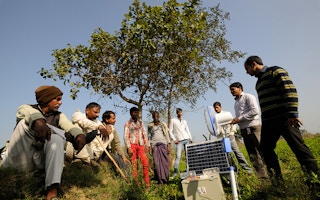India, like many developing countries, is grappling with how to fund a massive increase in its clean energy supplies as part of a government push to bring electricity to every household.
It plans to boost its renewable power capacity to 175 gigawatts by 2022 - four to five times more than it has now - which experts say will need an estimated $200 billion in investment.
There is likely be a 30 per cent shortfall in investment towards that goal based on current capital flows, said Gireesh Shrimali, director of the Climate Policy Initiative (CPI) India, a think tank that advises decision makers on green strategies.
“We need to attract institutional investment,” he said, referring to pension funds, insurance companies and sovereign wealth funds. “They are capable of meeting this gap, and the truth is they are not investing enough.”
But the falling cost of renewable power should encourage more private-sector money to flow in, he said, pointing to a recent auction in India’s state of Madhya Pradesh, where solar power was priced at around 5 cents per kilowatt hour - making it competitive with power produced using coal for the first time.
“Investors are starting to take renewable energy as a very serious asset class,” he said.
Shrimali and other experts at a discussion on financing the world’s low-carbon energy transition in Barcelona late last week grappled with how to lower the risks of investing in clean energy projects in developing countries - which are consistently higher than similar investments in wealthier countries.
In India, investors remain wary of potential problems like offtake risk - when agreements to purchase power do not deliver expected revenues on time - and currency risk, in which depreciation could leave them worse off, Shrimali said.
“
Investors are starting to take renewable energy as a very serious asset class.
Gireesh Shrimali, director, Climate Policy Initiative India
Payment guarantees and other instruments can be put in place to reduce those risks - and if this is done using public money, it can act as a lever for private capital to enter the market, the experts said.
Too small?
A major barrier for low-income countries is that they often lack clean energy projects that are seen as “bankable” - where financial returns are clearly defined - or big enough to warrant international interest, said Tancrède Voituriez, governance programme director at France’s Institute for Sustainable Development and International Relations.
But smaller projects, such as solar power in rural areas, should be funded by development banks and donors, he said.
“We really need to have a serious conversation with Senegal or Mali or wherever to say what are the genuine local needs that these banks could finance,” he added.
Efforts are underway at both national and international level to shift the dial.
On Tuesday, the World Bank said Zambia had signed agreements for a second mandate to develop utility-scale clean energy with Scaling Solar, a World Bank programme helping developing countries to procure low-cost, privately financed solar power.
Scaling Solar projects in progress in Zambia, Senegal, Madagascar and Ethiopia will develop and tender over 1.2 gigawatts of solar power combined, and the programme is planning to expand to Asia and the Middle East, the World Bank said.
Morocco is one country that has put in place its own financing arrangements for renewable energy projects, via the Moroccan Agency for Sustainable Energy (Masen). It has successfully arranged funding for one of the world’s biggest solar power plants on the edge of the Sahara desert.
The European Union, including the European Investment Bank, has paid for around 60 per cent of the Noor plant, while Masen issued Morocco’s first green bond of 106 million euros ($111.7 million), last November, to help finance it.
With Morocco aiming to get 52 per cent of its electricity from clean energy by 2030, up from around 28 per cent now, Masen is developing a wind energy portfolio alongside solar, said Nisrine Elkortbi, the agency’s director of finance.
Climate finance ‘gap’
Yet while more money is flowing into renewable projects around the world, experts say it is not happening fast enough.
Estimates for total investment in global infrastructure expected by 2035 range from $53 trillion to $90 trillion, said Luigi Carafa, a climate fellow with the Barcelona Centre for International Affairs (CIDOB), while climate finance in 2014 was $392 billion.
If that infrastructure - which includes transport, building and energy projects - is to be green and sustainable, then the “climate finance gap” is at least $3 trillion per year, he said, adding that public finance alone cannot close that gap.
Although the cost of renewable energy is falling, “we don’t see the mobilisation of capital which is required”, said Irene Monasterolo, post-doctoral associate with the Frederick S. Pardee Center for the Study of the Longer-Range Future at Boston University.
Issuance of green bonds and climate bonds is growing fast, but at less than $1 trillion, it is still a tiny fraction of the $90 trillion global bond market, she added.
Better policy frameworks are needed to develop the market, alongside more sophisticated classification of bonds, she noted.
Experts said work needs to crank up fast to turn countries’ climate action plans - including their emissions reduction targets - submitted for the Paris climate agreement into concrete projects that can be funded, and urged governments and big multilateral development banks to kick-start this process.
CPI’s Shrimali predicted that the required shift towards greener investment will start happening faster, now that renewable energy has become competitive with fossil fuels in many places, and cash flows are being generated over time.
“The transformation is just starting - it is going to take place over the next 10 to 15 years,” he said.
($1 = 0.9490 euros)
This story was published with permission from Thomson Reuters Foundation, the charitable arm of Thomson Reuters, that covers humanitarian news, climate change, resilience, women’s rights, trafficking and property rights. Visit http://news.trust.org/climate.










